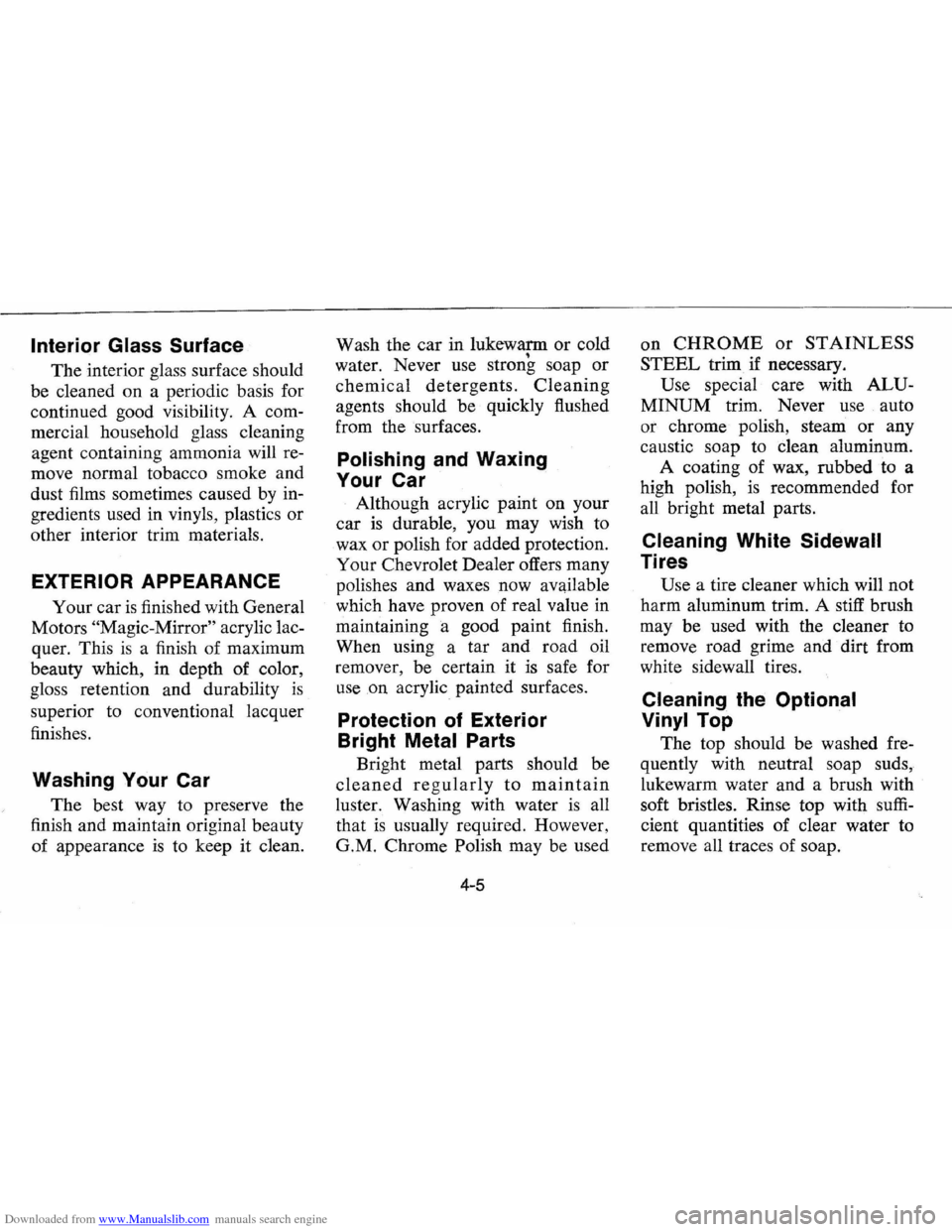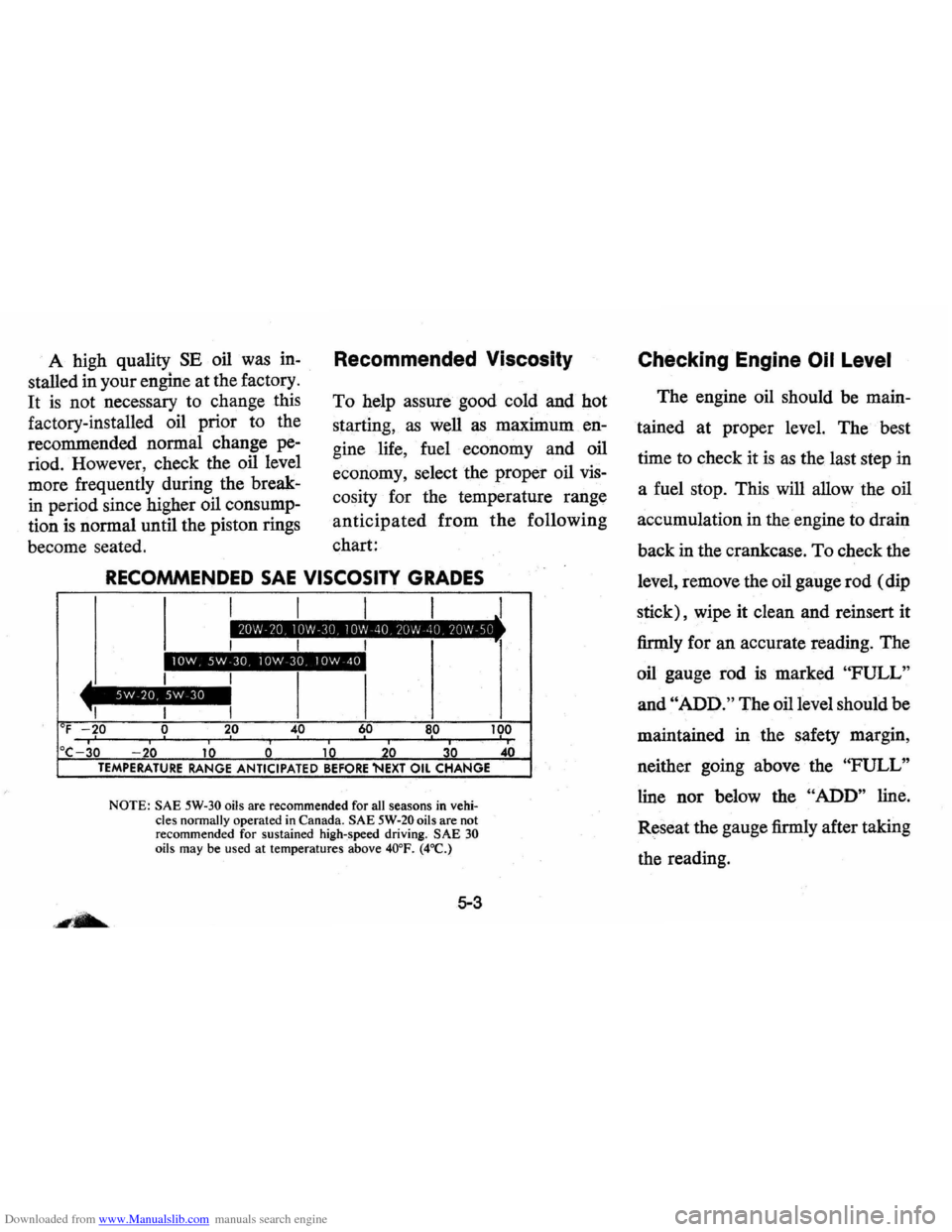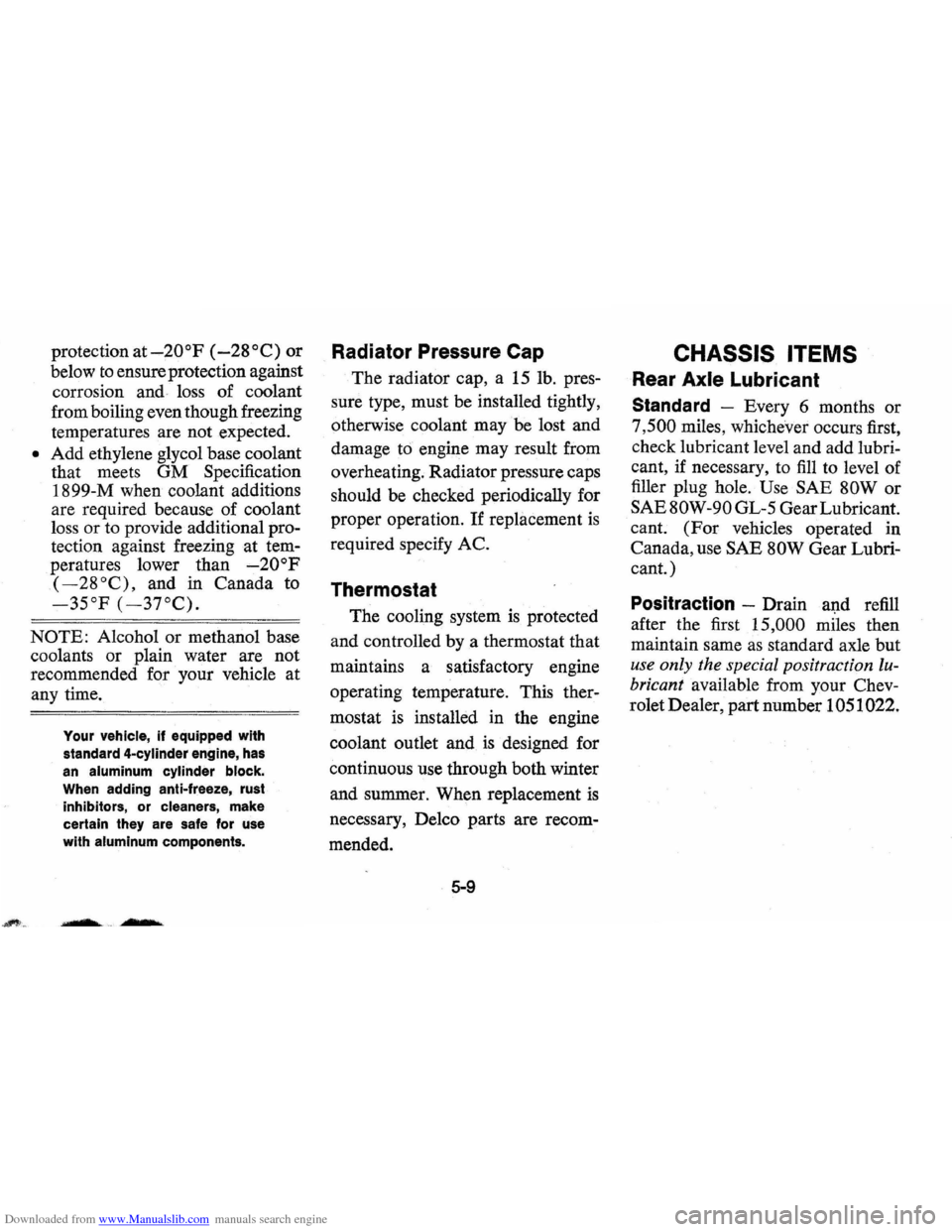1976 CHEVROLET VEGA recommended oil
[x] Cancel search: recommended oilPage 15 of 87

Downloaded from www.Manualslib.com manuals search engine Maintenance
More frequent vehicle mainte
nance
is required when using your
car to pull a trailer. Change the:
• Automatic transmission fluid
and filter each
15,000 miles,
(see Trailering brochure for addi
tional information).
• Rear axle fluid each 15,000
miles,
• Engine oil each 90 days or 3,000
miles, whichever occurs first,
• Positive crankcase ventilation
valve each
12 months or 15,000
miles, whichever occurs first.
• See index for important informa
tion on belts, cooling system care
and automatic brake adjustment.
Break-in Schedule
In addition to the new car preak-in
instructions in this manual, it is
recommended that your new car
be operated for
500 miles before
trailer towing.
If it is necessary to
tow during this period, avoid speeds
over
50 MPH and full throttle
starts. The same precautions should
be observed whenever a new en
gine, transmission or axle
is in
stalled in your car.
1-10
Page 55 of 87

Downloaded from www.Manualslib.com manuals search engine Interior Glass Surface
The interior glass surface should
be cleaned
on a periodic basis for
continued good visibility. A com
mercial household glass cleaning
agent containing ammonia will re
move normal tobacco smoke
and
dust films sometimes caused by in
gredients used in vinyls, plastics
or
other interior trim materials.
EXTERIOR APPEARANCE
Your car is finished with General
Motors
"Magic-Mirror" acrylic lac
quer. This
is a finish of maximum
beauty which,
in depth of color,
gloss retention
and durability is
superior to conventional lacquer
finishes.
Washing Your Car
The best way to preserve the
finish
and maintain original beauty
of appearance
is to keep it clean. Wash
the
car in lukewarm or cold • water. Never use strong soap or
chemical detergents. Cleaning
agents should be quickly flushed
from the surfaces.
Polishing and Waxing
Your Car
Although acrylic paint on your
car is durable, you may wish to
wax
or polish for added protection.
Your Chevrolet Dealer offers many
polishes
and waxes now ava,ilable
which have proven of real value in
maintaining a good
paint finish.
When using a
tar and road oil
remover, be certain
it is safe for
use
on acrylic painted surfaces.
Protection of Exterior
Bright
Metal Parts
Bright metal parts should be
cleaned regularly to maintain
luster. Washing with water is all
that
is usually required. However,
G.M. Chrome Polish may be used
4-5
on CHROME or STAINLESS
STEEL trim . if necessary.
Use special care with ALU
MINUM trim. Never use auto
or chrome polish, stearn
or any
caustic soap to clean aluminum.
A coating of wax,
rubbed to a
high polish,
is recommended for
all bright metal parts.
Cleaning White Sidewall
Tires
Use a tire cleaner which will not
harm aluminum trim. A stiff brush
may
be used with the cleaner to
remove road grime
and dirt from
white sidewall tires.
Cleaning the Optional
Vinyl
Top
The top should be washed fre
quently with neutral soap suds,
lukewarm water
and a brush with
soft bristles. Rinse top with suffi
cient quantities of clear water to
remove all traces of soap.
Page 60 of 87

Downloaded from www.Manualslib.com manuals search engine Gas Cap-The fuel tank filler cap
has a
two-step removal and in
stallation procedure plus a pres
sure-vacuum safety relief valve. It
is equipped with a double set of
locking tangs. To remove:
• Rotate cap one-half tum counter
clockwise to clear the first set of
tangs from the slots inside the
filler neck. This will allow any
residual pressure to escape.
• Pull the cap outward and rotate
one-quarter
tum counterclock
wise to clear second set of tangs
and remove the cap.
• To install, reverse this procedure.
NOTE: If this cap requires a re
placement, only a cap with these
same features should be used.
Fail
ure to use the correct cap can result
in a serious malfunction of the
sys
tem. Correct replacement caps may
be obtained from your authorized
Chevrolet dealer.
ENGINE ITEMS
Engine Oil and Filter
Recommendations'
• Use only SE engine oil.
• Change oil each 6 months or
7,500 miles, whichever occurs
first,
except under the following
conditions:
*
-driving in dusty conditions
-trailer pulling
-extensive idling
-short-trip operation at
freez
ing temperatures (engine not
thoroughly warmed-up) .
*Under these conditions, change oil
each 3 months
or 3,000 miles,
whichever occurs first.
• Operation in dust storms may
require an immediate oil change.
• Replace the oil filter at the first
oil change, and every second oil
change thereafter. AC oil filters
5-2
provide excellent engine pro
tection.
See your Chevrolet dealer for
ad
vice on the frequency of oil and
filter changes under unusual driving
conditions.
The above recommendations
ap
ply to the first change as well as
subsequent oil changes. The oil
change interval for your Chevrolet
engine
is based on the use of SE
oils and quality oil filters.
Oil
change intervals longer than those
listed above will seriously reduce
engine life and may affect
Chevro
let obligation under the provisions
of the
New Vehicle Warranty.
NOTE: Non-detergent and other
low quality oils are specifically not
recommended.
Only the use of SE
engine oils and proper oil and filter
change intervals assure you of
con
tinued proper lubrication of your
Chevrolet engine.
Page 61 of 87

Downloaded from www.Manualslib.com manuals search engine A high quality SE oil was in
stalled in your engine at the factory.
It is not necessary to change this
factory-installed oil prior to the
recommended normal change pe
riod. However, check the oil level
more frequently during the break
in period since higher oil consump
tion
is normal until the piston rings
become seated.
Recommended Viscosity
To help assure good cold and hot
starting, .
as well as maximum en
ginelife, fuel economy and oil
economy, select the proper oil
vis
cosity for the temperature rang¥
anticipated from the following
chart:
RECOMMENDED SAE VISCOSITY GRADES
I I I I 20N 20 lOW-3~ 10N')0 2UN ·;0 20,V sc
lOW 5w 30 lOW 30 lOW 40
TEMPERATURE RANGE ANTICIPATED BEFORE 'NEXT OIL CHANGE
NOTE : SAE 5W-30 oils are recommended for all Seasons in vehicles normally operated in Canada. SAE 5W-20 oils are not
recommended for sustained high-speed driving. SAE 30 oils may be used at temperatures above 40°F. (4°C.)
5-3
100 , i 40
Checking Engine Oil Level
The engine oil should be main
tained at proper level. The best
time to check it
is as the last step in
a fuel stop. This will allow the oil
accumulation in the engine to drain
back in the crankcase. To check the
level, remove the oil gauge rod (dip
stick), wipe it clean and reinsert it
firmly for an accurate reading. The
oil gauge rod is marked "FULL"
and "ADD." The oil level should be
maintained in the safety margin,
neither going above the
"FULL"
line nor below the "ADD" line.
Reseat the gauge firmly after taking
the reading.
Page 67 of 87

Downloaded from www.Manualslib.com manuals search engine protection at -20o
P (-28°C) or
below to ensure protection against
corrosion
and · loss of coolant
from boiling even though freezing
temperatures are not expected.
• Add ethylene glycol base coolant
that meets
GM Specification
1899-M when coolant additions
are required because of coolant
loss
or to provide additional pro
tection against freezing at tem
peratures lower than -20oP
(-28°C), and in Canada to
-35°P (-37°C).
NOTE: Alcohol or methanol base
coolants or plain water are not
recommended for your vehicle at
any time.
Your vehicle, if equipped with
standard 4-cylinder engine, has
an aluminum cylinder block.
When adding anti-freeze, rust
inhibitors, or cleaners, make
certain they are safe for
use
with aluminum components.
Radiator Pressure Cap
The radiator cap, a 15 lb. pres
sure type, must be installed tightly,
otherwise coolant may be lost and
damage
t6 engine may result from
overheating. Radiator pressure caps
should be checked periodically for
proper operation.
If replacement is
required specify AC.
Thermostat
The cooling system is protected
and controlled by a thermostat that
maintains a satisfactory engine
operating temperature. This
ther
mostat is installed in the engine
coolant outlet and
is designed for
continuous use through both winter
and summer. When replacement
is
necessary, Delco parts are recom
mended.
5-9
CHASSIS ITEMS
Rear Axle Lubricant
Standard -Every 6 months or
7,500 miles, whichever occurs first,
check lubricant level and add
lubri
cant, if necessary, to fill to level of
filler plug hole.
Use SAE 80W or
SAE80W-90GL-5 Gear Lubricant.
cant.
(Por vehicles operated in
Canada, use
SAE 80W Gear Lubri
cant.)
Positraction -Drain aJ,ld refill
after the first 15,000 miles then
maintain same
as standard axle but
use only the special positraction lu
bricant available from your Chev
rolet Dealer, part number 1051022.